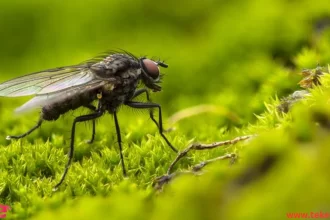The Iguana lizard is one of the most impressive reptiles in the animal kingdom, known for its large body, rough skin, and vibrant colors ranging from emerald green to dark brown. These lizards are native to the tropical regions of Central and South America, where they inhabit rainforests and rocky areas. Iguanas captivate both scientists and reptile enthusiasts due to their remarkable biological adaptations and unique social behaviors. In this article from teketrek, we will explore the life of this fascinating lizard, delving into its natural habitat, dietary habits, and reproductive behavior.
Information About the Iguana Lizard
The Iguana lizard, or the American Iguana, is a herbivorous reptile belonging to the Iguanidae family within the order Squamata. It is widespread in the tropical regions of Central America and the Caribbean. The name “Iguana” originates from the Caribbean Islands, where these lizards were first discovered. The species was scientifically described for the first time in 1768 by the Austrian scientist Josephus Nicolaus Laurenti.
It’s worth noting that the Iguana is an ectothermic reptile, meaning its body temperature fluctuates with its surrounding environment. Iguanas also possess a third eye on top of their heads, known as the parietal eye, which helps them detect potential predators from above, such as birds. Additionally, they have sharp vision in their primary eyes.
In the wild, iguanas can live up to eight years, but with proper care and attention, they can live up to twenty years. This lizard exemplifies environmental adaptability and survival flexibility, making it an inspiring subject in the realms of nature and advanced technological designs.

Why Is the Iguana Named So?
The Iguana’s name is steeped in history and culture, with deep roots in the past. The name “Iguana” is derived from the Spanish word “Iwana,” from the Taino language, spoken by the indigenous people of Central America. This lizard represents strength and resilience, making it a fitting name for such a creature. Besides the known species of the genus *Iguana*, there are several related genera within the same family also referred to as “iguanas.” The significance of this name highlights the biodiversity of these creatures and the historical context of their nomenclature, contributing to a deeper understanding of our natural and cultural heritage.
Types of Iguana Lizard
There are two main types of Iguana lizards:
- The Green Iguana: A popular pet around the world, the green iguana is characterized by its long tail, four legs, and a head directly connected to its body. It can grow up to one and a half meters long, including the tail, and weigh about nine kilograms. It has thick, tough skin that acts as a water barrier and possesses very sharp teeth that allow it to cut through tough plants.
- The Lesser Antillean Iguana: Native to the Lesser Antilles, this species is endangered due to habitat destruction. The Lesser Antillean Iguana resembles other lizard species in shape and structure, and it has the ability to change its skin color between green, blue, orange, and purple, helping it blend into its natural environment.
Is the Iguana Poisonous?
No, iguanas are not poisonous at all. Although some other types of lizards may have venom, the iguana itself does not possess any kind of poison. This makes them safe pets to keep at home without any fear of toxicity. Iguanas primarily feed on plants and fruits and are considered calm and friendly reptiles that can be easily handled if properly cared for.
Characteristics of the Iguana Lizard
The Iguana lizard is a prominent reptile with several notable characteristics:
- Large Size: Iguanas are among the largest lizards, with some reaching up to one and a half meters in length, including the tail.
- Excellent Adaptation: Iguanas have a high ability to adapt to changing environmental conditions, enabling them to survive in various natural habitats.
- Distinct Physical Structure: The iguana’s body features a spiny ridge running along its back and tail, adding to its strength and providing a means of defense against potential threats.
- Diverse Diet: Iguanas primarily eat fruits and vegetables, with the ability to consume insects when necessary, making them specialized herbivores.
- Friendly Behavior: Despite their large size, iguanas exhibit friendly behavior towards humans, making them beloved pets for many people.
- Lack of Venom: Contrary to some beliefs, iguanas do not possess any venom, making them safe to keep as pets.
Unique Characteristics of the Iguana Lizard
The Iguana lizard possesses a set of unique features that help it adapt to its environment and ensure its survival:
- Scaly Skin: Iguanas have strong scales that act as a protective shield against predators and harsh environmental conditions.
- Spikes: Iguanas have a row of spikes along their back, which they use for self-defense when necessary.
- Long Tail: The long, strong tail is a crucial part of the iguana’s anatomy, aiding in balance during climbing and serving as a defense mechanism.
- Forked Tongue: The forked tongue helps iguanas sense food and the environment’s scent, assisting them in locating food and avoiding danger.
- Excellent Vision: Iguanas have excellent vision, allowing them to detect threats and locate food efficiently.

Frequently Asked Questions
Is the Iguana a Lizard?
Yes, the Iguana is a type of lizard that lives in tropical and subtropical regions.
Is the Iguana a Pet?
Yes, iguanas can be kept as pets, but they require special care and suitable environmental conditions to ensure their health and well-being.
Are Lizards Warm-Blooded?
No, lizards are not warm-blooded; they are cold-blooded animals.
In conclusion, the Iguana lizard combines physical strength, environmental adaptability, and friendly behavior, making it one of the most fascinating reptiles in the animal kingdom.





